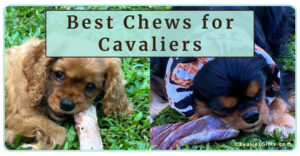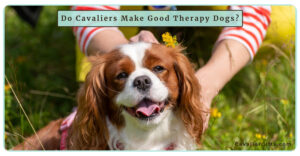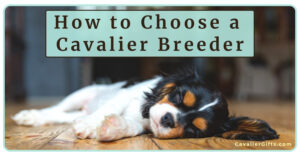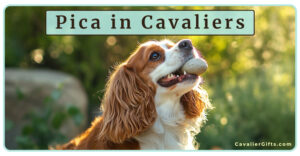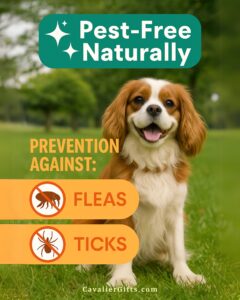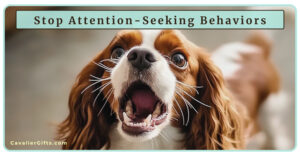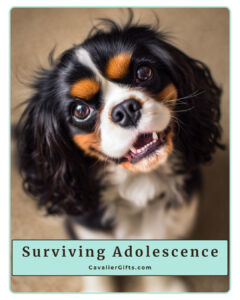Are Cavalier King Charles Spaniels Good for Therapy Dog Work?

 Today, I want to chat about a topic that is close to my heart: therapy dogs! Have you ever wondered if your Cavalier King Charles Spaniel would make a good therapy dog? It’s a common question and one that has a few caveats. First, it’s not all about the dog! I know, I know, it’s always all about Dexter, but with visiting therapy dogs, it’s about teamwork.
Today, I want to chat about a topic that is close to my heart: therapy dogs! Have you ever wondered if your Cavalier King Charles Spaniel would make a good therapy dog? It’s a common question and one that has a few caveats. First, it’s not all about the dog! I know, I know, it’s always all about Dexter, but with visiting therapy dogs, it’s about teamwork.
But what is a visiting therapy dog team, and what do they do? A therapy pet team is a person and their pet (sometimes cats, bunnies, etc.) who share their companionship and comfort with those in need, visiting places like hospitals, schools, and nursing homes. These teams engage in either Animal-Assisted Activities (AAA) or Animal-Assisted Therapy (AAT). AAA therapy dog teams engage in sessions without the presence of a medical professional or specific treatment goals, aiming simply to bring joy and comfort. Whereas AAT therapy dog teams work with healthcare providers in goal-oriented sessions aimed at addressing specific issues, with progress carefully measured and tracked throughout the process.
Being a good therapy dog team isn’t just about your Cavalier; it’s also about you. Both you and your CKCS are visiting as a team. You both must have the skills and knowledge required to visit people in a wide range of settings.
Let’s discuss what humans should be bringing to a Cavalier therapy dog team. As a therapy dog handler, it’s important to be comfortable when interacting with both people and your dog. You’ll need to be able to guide your Cavalier through different situations, encouraging them and keeping them safe and happy. Understanding your dog is key to becoming a therapy dog handler. You’ve got to be able to recognize the tiniest changes in behavior and body language, and quickly respond. And at the same time, you will be multitasking by staying engaged with individuals. It’s a balancing act, for sure, especially as you start out your journey as a therapy dog team.

Now, what personality should your Cavalier King Charles Spaniel have in order to make a good therapy dog? When it comes to a well-suited therapy dog, you can look at a few key traits. A good therapy dog should be reliable, predictable, and able to follow your cues with ease. That’s not to say they have to be robots and never get flustered, but as a general rule, you want a dog that is solid in their temperament. Your dog should be friendly with strangers, as your visits will be with strangers. At the same time, they should be poised, not jump on people, and be able to walk nicely on a leash around distractions, including food. It’s not just about loving new people; it’s also about having manners in new and unfamiliar environments.
Getting Started Training Your Cavalier to Become a Visiting Therapy Dog
It’s important that your Cavalier have basic obedience and manners. Walking on a loose leash in crowded places, around dogs, and on slick floors is a must. Leaving food or dropped pills on the ground is incredibly important for your dog’s safety. If your Cavalier knows tricks, that can be a great icebreaker and is also helpful when someone wants to look at your dog but not pet them. Dexter and I were a visiting therapy dog team for many years, and tricks and activities were by far his favorite visits! If your dog needs a refresher, enroll in a positive dog training class.
Subscribe to our @CavalierTipsandFun YouTube channel for more!
Google Ad Below
After your Cavalier has mastered his basic obedience skills in a variety of environments, look for a therapy dog training prep class. This may be a weekend class or one that spans 4–8 weeks. When I taught my therapy dog prep class, each week we covered a new topic to prepare the handlers and dogs for the actual work involved and the test. My students by far enjoyed skit night, where my volunteers and I role-played different scenarios, the teams interacted, and we discussed what was good and how they could improve in that situation. It was a hoot and very eye-opening for the upcoming teams.
When you and your Cavalier are ready to take your therapy dog evaluation, you will need to find an evaluator to assess whether you are ready for therapy work. But there is more than one therapy dog organization out there. Choosing the right organization is crucial. Some facilities have specific requirements, like only accepting teams evaluated by certain organizations. So, if you have your sights set on a specific organization, reach out to them first. If your dog is on a raw food diet or you provide your dog with titers vs. yearly vaccinations, not all therapy dog organizations accept that, but some do.
Speaking of organizations, there are plenty out there, each with its own unique criteria. Some of the most common ones include Alliance of Therapy Dogs, Pet Partners, Love on a Leash, and Therapy Dogs International. Be sure to check out their specific requirements before making your decision.
Subscribe to @DextertheDogandFriends for kid-friendly content!
During the evaluation, the evaluator will test your skills to ensure you’re ready to handle various situations with confidence. Once you’ve got the green light from your evaluator, send in your paperwork and fees. While you are waiting for your official badge, it’s a good time to start reaching out to facilities you’re interested in visiting. It’s best to meet with the director, take a tour, and get a feel for the environment without your dog. When you are ready to visit with your Cavalier, keep those initial visits short and sweet. It’s all about easing them into the new surroundings and ensuring they feel comfortable and confident in their role as a therapy dog.
And remember, if you don’t think therapy work is in the cards for your Cavalier, that’s perfectly fine. There are plenty of other enjoyable activities you and your Cavalier can explore together. But if therapy work is the journey you’ve chosen, then I wish you both the best of luck on this rewarding adventure.

Your comments and questions are always welcome below.
Join our vibrant Cavalier King Charles Spaniel community on Facebook, support our dedication to pet wellness on Patreon, and stay updated with our weekly newsletter for invaluable tips and insights into raising happy, healthy pets. Together, let’s make a difference in our dogs’ lives!
|
|

|

|
Google Ad Below







